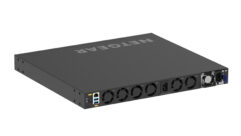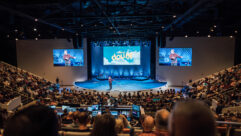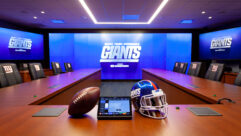

Mediatecture: Enter the Holodeck
As AV technology integrates seamlessly with new and renovated buildings, we increasingly encounter AV being used as architecture and architecture as AV.
Raymond Kent
We live in a wired world, saturated 24/7 with news, videos, music, social media, and more, right in the palms of our hands. People and companies want us to know who they are and what they have to offer. We’re bombarded with advertising, messages, and random thoughts in all formatssome direct, others subliminal. Why fight it?
One of the biggest problems with this phenomenon (among many) is that we’re less likely to relate to the world around us on an interactive, personal level when we have our noses in our iPods, iPads, iPhones, or iAnythings. We don’t experience anything other than what’s on the screen. But something called “mediatecture” is out to change that.
Many of us who grew up watching Star Trek: The Next Generation are familiar with the Holy Grail of mediatecture, which is loosely defined as the marriage of interactive media and architecture. The Holy Grail is, of course, the holodeck. On the holodeck, at the prompt of a voice command, one is transported to another time, location, or dimension, all from inside a seemingly empty black box. This creation of science fiction reflects a very real goal of today’s architects, in partnership with AV technologists and corporate partners: to design a built environment that pulls in experiences from beyond the room itself. And we’re not just talking about an interactive, immersive museum or a theme park, but every facet of every physical building.
Having spent a large portion of my career in architecture, entertainment, and technology, I’ve witnessed my fellow architects spend months—if not yearsdesigning interesting spaces where people can live, work, and play. As an entertainment professional and technology designer, I spend my time creating new ways for us to do the same thing, but in a connected world.
Today, a local indie band can lay tracks for an album and film its own music video for relatively little while tweeting its every move directly to fans. A few keystrokes and mouse clicks and—bingo—the band is on YouTube and beginning to rack up Facebook fans. Now, what if that band could stream a live concert to the wall of your house even when they’re halfway around the world? Then imagine what it would be like if you and your friends, watching the concert in your living room, could interact with other living rooms around the globe, as well as the musicians, in real time. In a corporate example, imagine a “window” at your office that looks out on a manufacturing floor, only that manufacturing floor is 3,000 miles away and that window is a 24/7 telepresence feed.
Technology giants such as Google, Cisco Systems, Tandberg, Apple, Verizon, Crestron, Extron, and others are hard at work to make transporting video data in high definition a seamless reality. Static images are so last century, as we’ve seen through the explosion of digital signage, which offers an affordable way for companies to broadcast their messages with motion and sound. And like moths to the proverbial flame, our eyes seek out the light (or the video monitor, or the projection screen).
Now take that idea one more next step and use the building itself or its interior walls as the surface for displaying media. Companies like Disney, Cedar Fair Entertainment Co., and Seaworld Parks & Entertainment, as well as many museums around the world, have already been adopting this idea of mediatecture and it’s quickly moving mainstream. Think of the lengths companies go to in order to project their messages in New York’s Times Square or other public venues. Last June, after a Houston Astros baseball game, fans were treated to giant 3D ants crawling all over an adjacent building. Slowly a huge can of Black Flag appeared and killed ’em dead. It was dramatic, huge, in-your-face, and a compelling marriage of media and architecture.
Mediatecture is undoubtedly a global movement. In Europe, Aether Architecture is pushing the boundaries of the convergence of new media and physical spaces. The company specializes in interactive architecture systems where spatial design and technology meet to create a memorable experience. A group called Interactive Architecture (interactivearchitecture.org) hosts forward thinkers and planners at an annual conference where they share ideas and experiences in creating and implementing technologies to enable the built environment to dynamically interact with the people around and in it. Another great outlet is the Media Architecture Biennale, hosted by the Media Architecture Institute, an organization founded in 2009 to promote discourse and offer real-world experience in implementing mediatecture designs.
What does this mean for the AV industry? It means that, once again, it’s even more important that architects bring AV designers onboard at the beginning of a project. A good architect should recognize that they are no longer just working with bricks and sticks, but designing elastic, dynamic, breathing spaces in which information is accessible at the occupant’s fingertips. The space must recognize the client as much as the client recognizes the office environment.
As an architect and technologist, I can tell you that AV technology is no longer just window dressing. Corporations want and need to deliver active content and brand context down to the individual level. Their bottom line depends on it. The collaboration between AV designer and architect will help shape a space, the material choices made, content development, and the technology essentials needed to pull off the seamless integration of a new, interactive built environment.
The architect and the AV designer must come to the table with a free and open mind as to how to they’ll accomplish the end game. The AV designer, in particular, will help define what’s possible with current technology while at the same time challenging manufacturers to push the limits of their products in an effort to create a holodeck.
And, of course, the client must be willing to take a leap of faith and think beyond the hand that’s holding his iPhone.
Raymond Kent, CTS, Assoc. AIA, LEED AP BD+C, is an award-winning technology and entertainment designer who works with leading architecture and performing arts companies.










